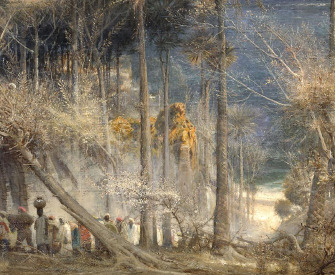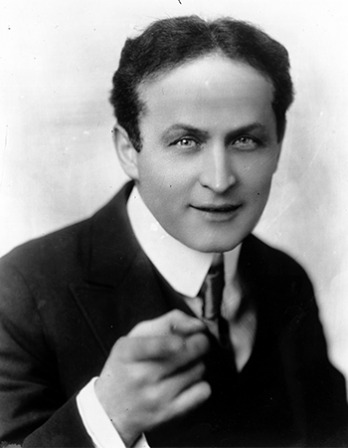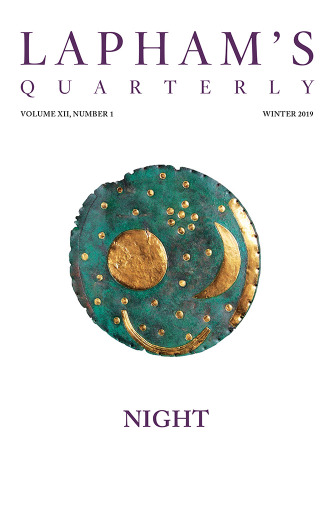The criminal is the creative artist; the detective only the critic.
—G.K. Chesterton, 1911From the Drawing Room to the Gutter
Crime fiction affords its readers a way to acknowledge the world’s violence without either succumbing to despair or believing it can be made to go away.
By Charles Taylor
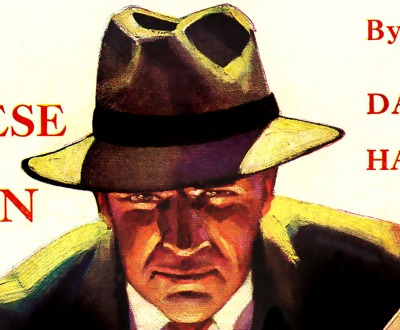
Depiction of Dashiell Hammett’s character Sam Spade, cover of Black Mask magazine, September 1929. Courtesy James Vaughan.
The trouble with the question, Is the crime novel literature? is that it implies that something has to rise to the level of art before it can be worthy of our attention. When critics write that a crime novel “transcends the genre,” they believe they’re paying a great compliment. But it’s backhanded, implying that the whole project isn’t worth doing in the first place. For them, “whodunits” will forever and always be whodunits and nothing more. That very term—like the equally-dismissive “mysteries”—tells you how out of touch the people who use it are with the reality and variety of crime fiction. The judgment is handed down from a literary establishment which fails to see that the contemporary literary novel has itself become a kind of genre writing. Why else is nearly every new novel that’s an accomplished feat of storytelling invariably described as “old-fashioned”? What type of novel can’t be described as genre writing? The realist novel? The experimental novel? The nouveau roman? The question of whether literature is high or low is on some level a way for a critic to evade the job of focusing on the particulars of a work, of describing the experience of reading it, and of suggesting how it relates both to other fiction and to its moment.
While it’s a mistake to equate popularity with worth, endurance isn’t the same thing as popularity, and as a genre the crime novel has endured for more than a century. Edgar Allan Poe usually receives the credit for writing the first detective story with the publication of “The Murders in the Rue Morgue” in 1841. After Poe, there are faked police “memoirs” and intermittent bestsellers until—with Sherlock Holmes’ initial appearance in the 1887 Beeton’s Christmas Annual—Sir Arthur Conan Doyle gives us the first really memorable fictional detective. Among the many reasons why the mystery has endured is a basic one: its form and movement together are a metaphor for the experience of reading.
A reader is nothing if not a detective. What prompts the reading of fiction is the desire to find out what comes next—an impulse all too easy to trivialize. Something has gone seriously wrong with our understanding of why people read when a good critic like James Wood talks about “the essential juvenility of plot.” Asked about that phrase in an interview, Wood said: “I like destroying the tyranny of plot…. I don’t think I need a plot to sustain my enjoyment. Formally speaking, if you really did believe in plot you’d say, ‘I can’t reread Anna Karenina, because I know what happens.’ But it’s obvious that there are deeper, more sustaining beauties underneath. Or if you go to Lear, you know what’s going to happen, but the joy is in seeing new facets.”
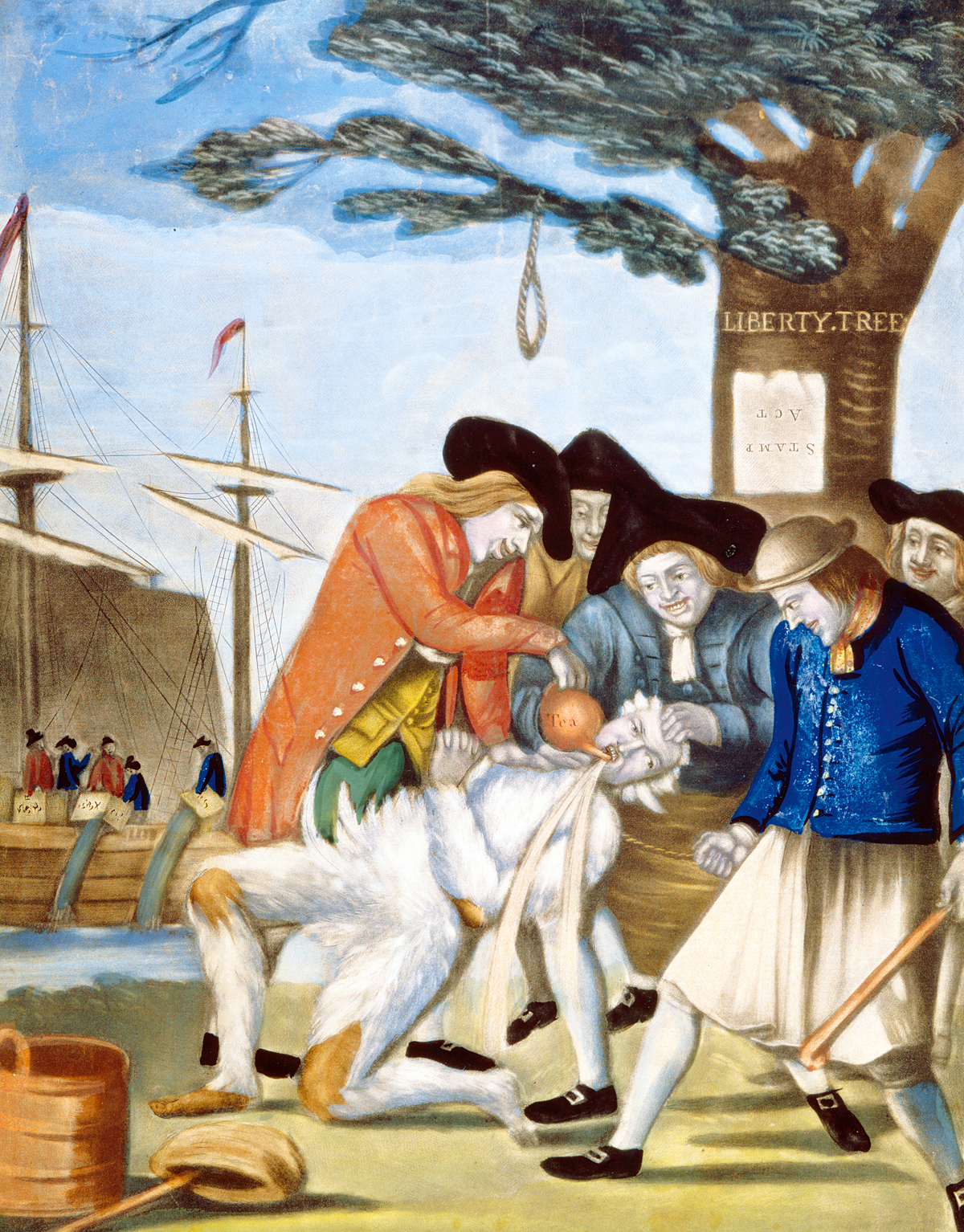
The Bostonians Paying the Excise-Man or Tarring and Feathering, by Philip Dawe, 1774. United States Library of Congress's Prints and Photographs division, Washington D.C.
But the foundation for the discovery of those sustaining beauties, those new facets, is the plot. The agonies and glories of Anna Karenina or King Lear can’t be divorced from the narrative line, and the pleasure of good storytelling—the sense of recognition it imparts—doesn’t end even if we already know how the story does. It’s the same with biography and history. In Speak, Memory, Nabokov says that writing a memoir is discovering the plot of your own life. The historian John Demos begins The Unredeemed Captive—his wonderful account of the 1704 Indian kidnapping of the minister John Williams and his family—with the line, “Most of all, I wanted to write a story.”
Still, if all that mattered in crime fiction was the revelation—waiting for the next turn of the screw and the neat resolution on the last few pages—it’s likely the genre would have remained as it was in the golden age of British mysteries, roughly from the twenties to the early forties, when amateur detectives like Margery Allingham’s Mr. Campion or Agatha Christie’s Miss Marple and Hercule Poirot were forever stumbling onto corpses in decidedly upscale surroundings. The sleuths—usually smarter than the police, if any were on the scene—approached crime solving as a social director approaches a rainy day: something to be gotten through with good spirits intact. The good spirits weren’t often shared by the characters whose secrets were being uncovered and who tended to regard Miss Marple and Mr. Campion as persistent irritants. Mysteries written in this style today are almost always period pastiches. The contemporary Scottish crime novelist Val McDermid argues that the wittiest of the golden-age mysteries were already pastiches—which is why it seems silly to take the decidedly polite surroundings of these books as evidence of a blinkered, cucumber-sandwich sensibility.
What happened to the genre can be summed up by Raymond Chandler’s remark that Dashiell Hammett took murder out of the drawing room and put it back in the gutter where it belonged. On this side of the Atlantic in the thirties, the British armchair detectives suddenly were joined by hard-nosed shamuses, like Hammett’s Sam Spade or The Continental Op and Chandler’s Philip Marlowe. The action shifted from the country house to back alleys and bad streets—or, sometimes, to the offices and homes where the mud of those streets had been tracked in. The new style of detective story—beginning to appear in pulp magazines like Black Mask—fit both the violence and casualness of the American character, drawing an unconscious line from the wildness of the frontier to the wildness of the big city, and showing much less faith in the possibility of order. The police in the English mysteries might have been bumblers; in the New World, they were often thugs in uniform, frequently as corrupt as the crooks they were supposed to be arresting.
Compare these two passages—both from 1929. This is from Allingham’s The Black Dudley Murder:
The weirdness of the great stone staircase and unlit recesses was even more disquieting than Abbershaw had imagined it would be. There were flutterings in the dark, whisperings, and hurried footsteps. He was by no means a nervous man, and in the ordinary way, an experience of this sort would probably have amused him faintly, had it not bored him. But on this particular night and in this house, which had impressed him with such a curious sense of foreboding ever since he had first seen it from the drive, he was distinctly uneasy.
And this is the opening paragraph of Hammett’s first novel, Red Harvest:
I first heard Personville called Poisonville by a red-haired mucker named Hickey Dewey in the Big Ship in Butte. He also called his shirt a shoit. I didn’t think anything of what he had done to the city’s name. Later I heard men who could manage their r’s give it the same pronunciation. I still didn’t see anything in it but the meaningless sort of humor that used to make richardsnary the thieves’ word for dictionary. A few years later I went to Personville and learned better.
Both passages employ the conventions of their respective milieus. The name Abbershaw is as suited to the English country house as Hickey Dewey is to a gin mill in Butte, and Dewey’s mispronunciation of “Personville” introduces the sense of foreboding just as clearly as does Abbershaw’s great stone staircase. What you cannot imagine in Allingham or Christie is a chapter entitled “The Seventeenth Murder” or a body with part of its jaw blown off. Or a hero who does not turn the suspect over to what was once called “the proper authorities” but takes it upon himself to punish the perp—and with sadistic relish. Here’s Hammett’s Continental Op talking to the man who hired him: “Your fat chief of police tried to assassinate me last night. I don’t like that. I’m just mean enough to want to ruin him for it. Now I’m going to have my fun. I’ve got ten thousand dollars of your money to play with. I’m going to use it opening Poisonville up from Adam’s apple to ankles. I’ll see that you get my reports as regularly as possible. I hope you enjoy them.”
Not every crime writer who followed Hammett adopted the hardboiled American voice, but they absorbed his rejection of the classic mystery’s claim to be about the restoration of order. The new forms of American crime fiction insisted that the bloodstains could never be removed from the carpet—violence that leads inevitably to more violence so thoroughly disrupts the status quo that order seems at best fragile, at worst a lie.
When Edmund Wilson—a great critic and a great snob—took swipes at the detective novel in a series of pieces published in The New Yorker in 1944–1945, he was setting the tone for many of the literary objections to the genre that would follow. Wilson recognized that the power of Raymond Chandler was “not simply a question of a puzzle which has been put together but of a malaise conveyed to the reader.” He concluded that he always felt cheated at the end of detective novels because the explanation of the mysteries did not equal that sense of malaise. Apparently it didn’t occur to Wilson that Chandler was making the precise point that explanations never can account for, never ameliorate, our experience of violence.
Despite Wilson’s attacks, the private-detective novel remains the backbone of American crime fiction. And after Hammett, it’s Chandler and then Ross Macdonald. Chandler’s voice may first attract the eternal adolescent in us, the one outraged by injustice and appalled by hypocrisy. Philip Marlowe’s appeal lies in the perception of him, to borrow Ross Macdonald’s description of how Chandler wrote, as a “slumming angel,” too wised up to wave any flags but, like the wounded idealist played by Humphrey Bogart Casablanca, essentially fighting the good fight.
And so it’s in Chandler that we confront the sentimentality beneath the hard veneer of much private-detective fiction. At the end of Farewell, My Lovely, a cop even calls Marlowe a sentimentalist, a charge to which the private eye owns up. He ends Farewell, My Lovely with, “You could see a long way—but not as far as Velma had gone” and The Long Goodbye with, “I never saw any of them again—except the cops. No way has yet been invented to say goodbye to them.” I can resist those lines about as easily as I can resist Sinatra singing “Deep in a Dream.” You could accuse Chandler of rank sentimentality, but he has a lasting power because he possesses qualities that adolescents and sentimentalists lack: palpable experience, a sense of irony, and humor that isn’t rooted in self-pity. Try reading Chandler back to back with The Catcher in the Rye, and the distinction becomes clear.
In Ross Macdonald’s Lew Archer series, the voice of the private detective takes on a stern, at times disapproving, gentlemanliness. As with Chandler, the location is still Southern California, but no longer Los Angeles’ mean streets or seedy bars. Archer—whose aim, as his name implies, is true—plies his trade in the wood-paneled offices of lawyers and university deans, in respectable upper-class homes, and respectably shabby middle-class ones. “The lawyer, whose name was John Truttwell,” begins The Goodbye Look, “kept me waiting in the outer room of his offices. It gave the room a chance to work me over gently. The armchair I was sitting in was covered in soft green leather. Oil paintings of the region, landscapes and seascapes, hung on the walls around me like subtle advertisements.”
The malaise that Edmund Wilson identified in Chandler was a social condition; in Macdonald it’s a legacy of birth, passed on through the blood. The Archer novels involve long-buried family secrets that come to light, as if mocking both acquired wealth and the idyllic California setting. This is from The Doomsters: “Grantland had come up beside her. She turned and gave him a little smile, her smudged mouth doubling its meaning. Of the three, she and Grantland formed the paired unit. Her husband was the one who stood alone. As if he couldn’t bear that loneliness, he turned on his heel, walked stiffly down the veranda steps, and disappeared through the front door of the greenhouse.”
Philip Marlowe’s wisecracks are far away in the Lew Archer books. I can’t recall a single laugh in the series. But where toughness is often a disguise for sentimentality in Chandler, Archer’s impulse to judge and moralize is a cover for the most hardheaded kind of empathy. It wounds him to see human frailty, and reading these books hurts. Psychology comes into play more fully in Macdonald than it had in Chandler or Hammett. In Archer’s world, people believe the vastness of the country can allow them to outrun themselves. His characters have gone to the literal edge of America—seeking paradise and their manifest destiny—only to find themselves atop a precipice from which they are always in danger of falling.
Beyond Hammett, Chandler, and Macdonald, the hardboiled voice produced a variety of styles and sensibilities—from the sheer misanthropy of dozens of remembered and forgotten pulps, to the tortured romanticism of Cornell Woolrich, to Jim Thompson’s descents into psychosis. For a select group of world-class wiseasses, hardboiled style provided the deadpan template for what might be called hardboiled farce—Joe Gores in his DKA Files series, about a wily bunch of repo men; Carl Hiaasen in his accounts of the corruption of Florida’s body politic and the state’s natural resources; and the master of them all, Ross Thomas, a born entertainer who treated his rogues with the appalled amusement and sagacity of the late filmmaker Luis Buñuel. Anyone wondering where screwball comedy has gone should look at these writers, who, with a kind of manic discipline, keep the elements of escalating farce plots spinning in the air like so many juggler’s balls.
To my mind the only great American crime writer to emerge since Macdonald is Elmore Leonard. He begins a chapter in Killshot with the wonderful few sentences, “Richie Nix bought a T-shirt at Henry’s restaurant in Algonac that had it’s nice to be nice written across the front. He changed in the men’s room: took off his old T-shirt and threw it away, put on the new one looking at himself in the mirror, but then didn’t know what to do with his gun. If he put his denim jacket back on to hide the nickel-plate .38 revolver stuck in his jeans, you couldn’t read the T-shirt. What he did was roll the .38 up inside the jacket and carried it into the dining area.”
There, in one lean paragraph, is America’s native, naive optimism keeping company with America’s casual violence. The traditional good guy has almost completely disappeared in Leonard. There are cops and Feds, but they’re mostly an annoyance. And when one does come to the fore, like the U.S. Marshal Karen Sisco in Out of Sight, she’s interesting because she falls for a bank robber on the lam. Martin Amis, speaking for himself and Saul Bellow, famously remarked, “For an absolutely reliable and unstinting infusion of narrative pleasure in a prose miraculously purged of all false qualities, there [is] no one quite like Elmore Leonard.” I don’t think I’d trust any writer who read Leonard and didn’t feel admiration. It’s not just his mastery of his characters’ voices—or that the prose is whittled to perfection without ever seeming fussed over—it’s that Leonard is an irresistibly mature writer. Leonard’s books are filled with people—often middle-aged people—surveying the failures and compromises of their lives and trying to find a way to rearrange or accept the cards they’ve been dealt. And Leonard avoids the pitfalls of both hardboiled writing—the pushy barroom philosophizing which insists that the hard, dirty truth is the only truth—and “literary” writing, which confuses depressive dreariness with honesty. The bank robber in Out of Sight, the airline attendant caught in a federal sting and her bail bondsman partner starting to see the limits of his life in Rum Punch, the woman confronting the immaturity of the husband she loves in Killshot—all of these characters know they can’t hide from themselves anymore, can’t believe in false hope.
In what’s currently the strongest series of detective novels being written by an American, Kris Nelscott’s Smokey Dalton series, the hero Smokey is a black private detective forced to flee Memphis with a young boy who has witnessed Martin Luther King Jr.’s assassination (and seen that it wasn’t James Earl Ray who pulled the trigger). The pair relocate to Chicago under assumed names and pose as father and son. Nelscott’s sequence is nothing less than an attempt to map the moment when the hope of the civil-rights years gives way to the anger of the Black Power movement and the law-and-order ethos of the Nixon administration. Reading Nelscott, you realize that the shock of those years has never been smoothed over, never settled.
One of the appeals of crime novels is the simple desire on the part of the reader to be talked to as an adult and to see the world the way it is—a complicated place usually devoid of simple solutions or easy explanations. I don’t want to discount the escapism that they offer. When your boss is getting on your case or you’re squabbling with your spouse—when everyone you know strikes you as an unrelenting pain in the ass—there can be nothing more pleasurable than sinking into some grubby piece of pulp from which all pretense of polite society has been erased. And though the pleasures are a lot less cynical, old-style mysteries—particularly the English ones—can offer a plummy, comforting diversion from the sorrows of a rainy day.
But comfort does not always equal escape. Comfort, a kind of comfort, can come from trying to understand, or at least trying to acknowledge, the presence of what we can’t understand. Speaking about the permutations that figurative painting has gone through from the Renaissance to Cubism, the artist David Hockney once said, “The urge to depict and the longing to see depictions is very strong and very deep within us…We don’t create the world. It’s God’s world, he made it. We depict it, we try to understand it. And a longing like that doesn’t just disappear in one generation.”
Crime fiction affords its readers a way to acknowledge the world’s violence without either succumbing to despair or believing it can be made to go away. That sounds like a contradiction. How is it possible not to abandon all hope of a problem that can’t be solved? The heroes of detective fiction, and perhaps its readers, answer the question by refusing the luxury of nihilism—in the recognition of a difference between chaos and the chaotic, and in the dogged insistence on treating people as subjects rather than objects, knowing that the chance, or even likelihood, of failure does not absolve you of the responsibility to act. For the protagonists of crime fiction, there’s always someone in need of a helping hand or a bullet in the head; they act because, What the hell else can you do?
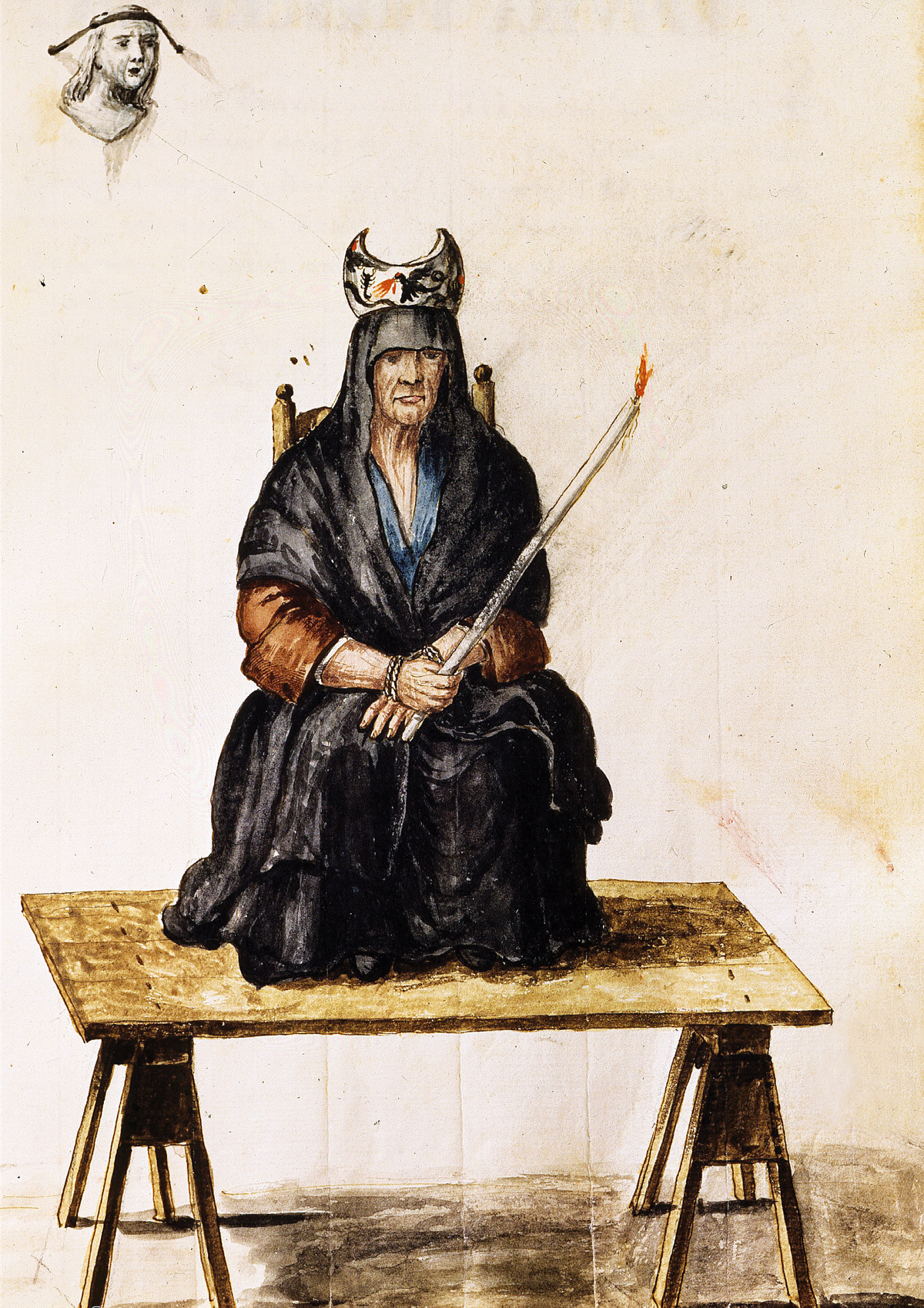
Punishment of a Sorceress, by Jan van Grevenbroeck, eighteenth century.
It’s no coincidence that crime fiction has persisted, prospered, and proliferated in proportion to the longing to come to terms with the world’s violence that over the course of the shell-shocked twentieth century has intensified among the world’s readers—of newspapers as well as of the novels of Chandler and Leonard. Very little is actually settled in the best contemporary crime fiction. That’s true even of the police procedural, a genre that the current crop of Brits (Reginald Hill, Ruth Rendell) and Scots (John Harvey, Val McDermid, Ian Rankin) have assayed so smashingly. The cops in these books may be in a profession that works to restore order, but they have very little faith in the undertaking.
Here is Rankin’s Inspector Rebus at the end of a case in Let It Bleed:
He headed in the vague direction of Craigmillar, then thought better of it. He’d go home instead. And pray there were no reporters camped outside. When he went home, he took the night home with him and had to soak and scrub it away, feeling like an old paving slab, walked on daily. Sometimes it was easier to stay on the street or sleep at the station. Sometimes he drove all night, not just through Edinburgh: down to Leith and past the working girls and hustlers, along the waterfront, South Queensferry sometimes, and then up on to the Forth Bridge, up the M90 through Fife, past Perth, all the way to Dundee, where he’d turn and head back, usually tired by then, pulling off the road if necessary and sleeping in his car. It all took time.
There’s nothing rewarding being described in that passage, nothing reassuring or restorative. It’s just the sense of an unending chore that provides only a brief respite from the horrors of the world—not just the overt horrors, but the private sins and everyday betrayals. The home that crime fiction has chosen for itself is often overlooked in pointless discussions about whether the road taken is high or low. Any fiction that gives readers some way of grappling with the most unsettling facts of contemporary life—that tries, as any art should, to engage experience before judging it—is hardly a lowly enterprise, even if the territory it’s working isn’t the classiest.
